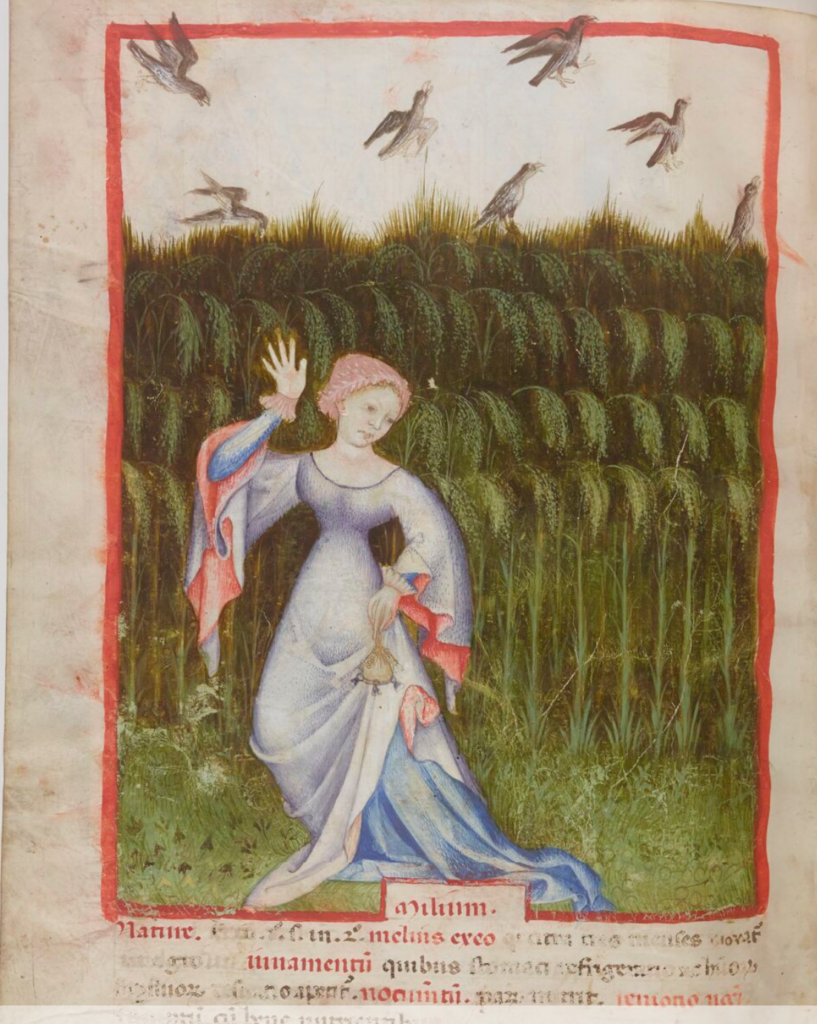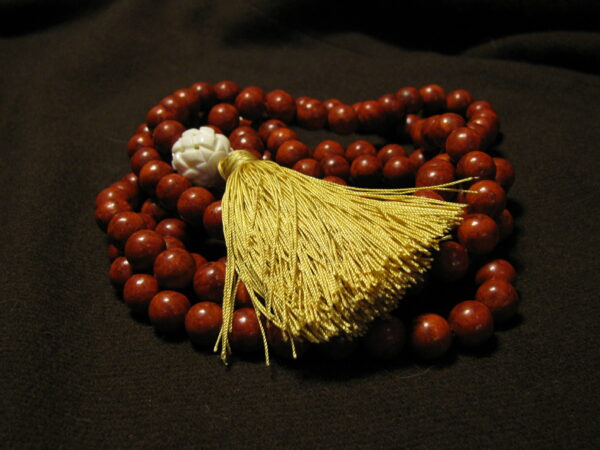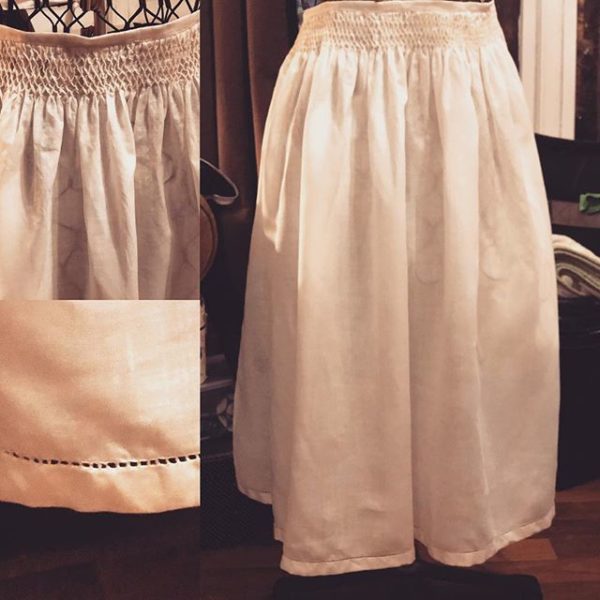Dress in the Italian Style
What, Where, When:

- This dress is based on an image from folio 52v of the manuscript BNF Latine 1673, a Tacuinum Sanitatis edition that was copied and illustrated in Milan around 1390-1400. 1
- It is an overgown, intended to be worn over a second, supportive undergown with long sleeves.
Please note: pictures of the gown itself were lost during a website update; I hope to find them again and add them eventually.
Source:
The gown is based on manuscript BNF Latine 1673, folio 52v. Further details are taken from folios 46, 79, 82v, and 84.
Materials:
Fabric:
The exterior fabric is a silk/wool blend, chosen for its color and drape, which closely match those in the illumination. (Actually, the illumination was chosen to best utilize the fabric, as many of this sort of projects begin.) It is lined in a plain-weave silk, dyed using modern methods to approximate the color in the illumination. Both the purple and the pink/orange are colors which can be achieved with period dyes, logwood for the purple and madder for the pink/orange. 2
Mixed fiber fabrics such as silk/wool, wool/linen or silk/linen were common in period, although mixed fiber threads were not. For instance, a fabric with a silk warp and wool weft was known as “buratti” in Venice.3
Threads and other Embroidery Materials:
The embroidery is stitched with twisted silk threads – a single strand of (12-stand) Splendor silk for the leaves and couching, a less-twisted shinier silk for the flowers. Gold is “Treasure Braid”, a nylon-based synthetic, as I did not have the money nor the skill for real metallic threads. The pearls are freshwater pearls, stitched with polyester thread. (Since this garment will be worn fairly often, strength was important, and I was unable to find silk thread that felt strong enough to hold the pearls and that also matched the garment well.
The gown is also stitched in polyester – the original plan was silk thread, but when the decision was made to use the machine for seams, I was afraid silk would cut the fabric of the dress.
Tools:
Due to the size of the work, I used a modern embroidery frame; although I attempted to use a smaller, period (slate) frame I was unable to mount the fabric to maintain tension over large areas like the sleeves. Likewise, using period needles was outside the scope of this project.
Design and Techniques:
Dress Pattern:
The gown pattern is based on 4 panels and 4 gores, for maximum fabric conservation. The panels are cut as rectangles, approximately the length of the gown + several inches and a quarter of the width of the fabric (60 inches). They are fit directly on the wearer, who must be wearing the supportive underdress intended to be worn under the final gown.
I used a straight front technique for this gown in an effort to improve the shaping around the bust, all shaping is done on the side and back seams4. (My first attempt at this gown had a curved front seam, which when combined with the natural stretch of the wool twill it was made of, led to unpleasant bagginess.)
The sleeves were cut to maximize the drape of the fabric – the wrist edge is on the straight of grain, and flares naturally from the shoulder. They are slightly larger/more dramatically flared than those in the Tacuinum ; however, the sleeve styles varied extensively throughout the Tacuinum and I wanted more “canvas” for embroidery, so I feel the larger size is appropriate.
Embroidery:
Several of the gowns in the Tacuinum appear to be embroidered, specifically folio 84v appears to have embroidery on the neckline and sleeves. I choose to use gold and pearls for the embroidery because I had recently read an inventory5 of a French Countess’s wardrobe after her death in 1426, which mentioned several dresses “with large sleeves” so embellished. The vinework pattern is based on illumination of the time. It is executed in chain stitch, couching and satin stitch, all common to 14th century embroidery.
Gown Construction:
The gown is machine sewn (the original plan was to handsew it but time and other considerations intervened). It is flat-lined (exterior and interior fabric are treated as one) – I have not found documentation of how linings were treated in the 14th century, and treating them as one improved the drape of the fabric. Seams are finished by flatfelling.6
Accessories:
The gown itself is worn over a supportive undergown, which shapes the figure, especially the bust. Chemise, stockings,etc. are also worn. Unlike French images of the same time period, the ladies in the Tacuinum wear their hair in braids wrapped around the head, and veils are very rarely worn. To achieve this style, “Italian hair taping”, in which a braid is sewn to the head with a blunt needle and decorative ribbon, is used (in my case with false hair). A thin, decorative silk veil is worn over the hair, as shown in folios 42 and 79 of the manuscript. The stuffed ermine? Not period in the slightest.
- Manuscript is available at the Bibliotheque Nationale website, found here. ↩︎
- Information from a class by Baroness Magdalena de Hazebrook, taken at Atlantia Winter University 2006. ↩︎
- Mola, L., “The Silk Industry of Renaissance Venice”, John Hopkins University Press, Baltimore, 2000; referenced at Class Act Fabrics ↩︎
- Fitting was assisted by Lukas Byerly, without whose assistance this project could not have been completed – I am not dexterous nor flexible enough to fit this style gown on myself without help! ↩︎
- From Revue des Sociétés Savantes des Départements. 6th series, volume VI, 1877, 2nd semester. The goods inventoried apparently belonged to Alix de Baux of Avellino, Vicomtesse de Turenne and Dame de Baux et cetera, who was the daughter of Raymond II de Baux, Sire de Baux, Count d’Avellino and Jeanne de Beaufort (1351-1404). She married Odon de Villars, titular Count of Geneva (d. 1413) and in 1418 she married Count Konrad IV von Freiburg und von Neuenburg (d. 1424). She lived (circa 1367-1426). A translation of this source by Katharine Barech can be found here. ↩︎
- Flatfelled seams are documented in medieval wool garments, as seen in Heather Rose Jones’s article on the subject. ↩︎

